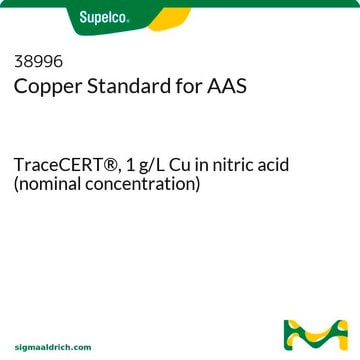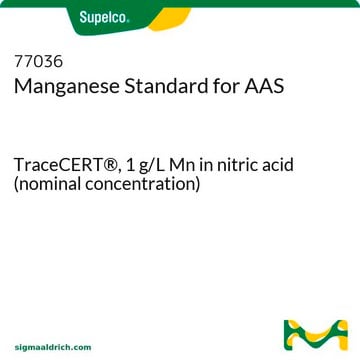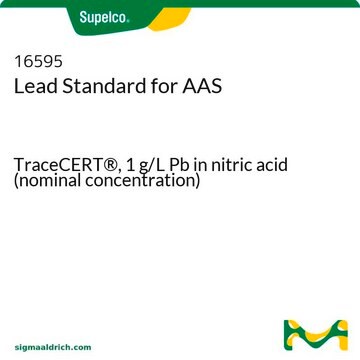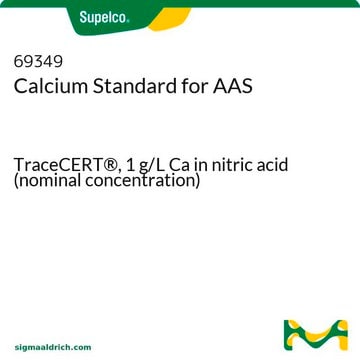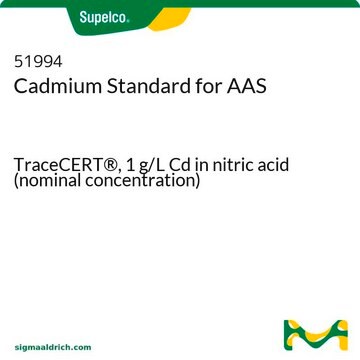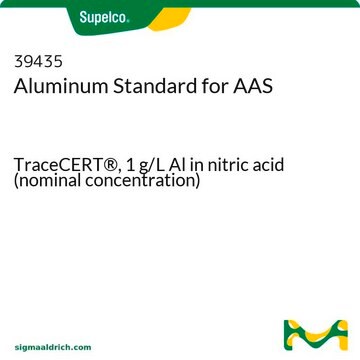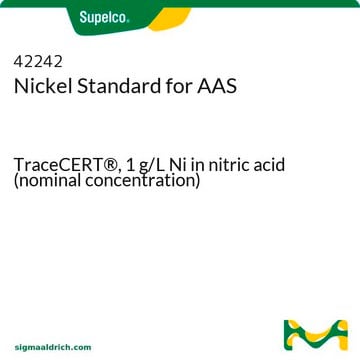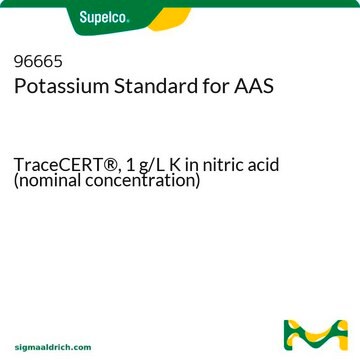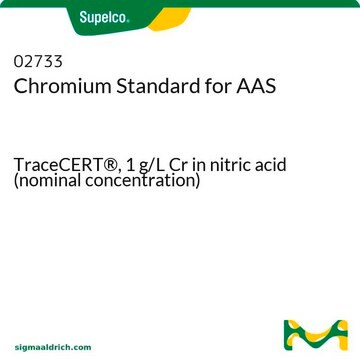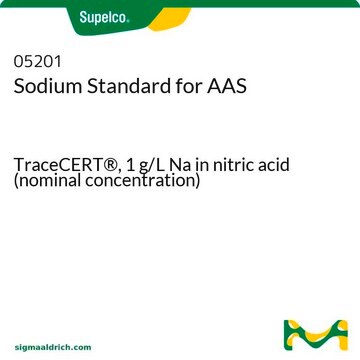16596
Iron Standard for AAS
TraceCERT®, 1 g/L Fe in nitric acid (nominal concentration)
Synonym(s):
Iron Standard for AAS (1 g/L Fe in 2% nitric acid)
Sign Into View Organizational & Contract Pricing
All Photos(1)
About This Item
UNSPSC Code:
41116107
NACRES:
NA.24
Recommended Products
grade
certified reference material
TraceCERT®
Quality Level
product line
TraceCERT®
concentration
1 g/L Fe in nitric acid (nominal concentration)
technique(s)
AAS: suitable
ICP: suitable
application(s)
industrial qc
pharmaceutical
format
single component solution
Related Categories
General description
This certified reference material (CRM) is produced in accordance with ISO 17034 and characterized in accordance with ISO/IEC 17025. This CRM is traceable to SI unit kg and measured against primary material from a National Metrology Institute (NMI), e.g. NIST.
Please visit ISO certificates and Site Quality Self-Assessments to access the current certificates of accreditation.
Download your certificate at http://www.sigma-aldrich.com to view certified values, including uncertainty and expiry date.
Please visit ISO certificates and Site Quality Self-Assessments to access the current certificates of accreditation.
Download your certificate at http://www.sigma-aldrich.com to view certified values, including uncertainty and expiry date.
Application
Iron standard has been used as standard stock solution in flame atomic absorption spectrometry (FAAS) method for determining iron and polybdenum in dietetic pharmaceutical preparation.
Iron standard has been used as standard stock solution in flame atomic absorption spectrometry (FAAS) method for determining iron and polybdenum in dietetic pharmaceutical preparation.
Analysis Note
1 g/L Fe in 2% nitric acid, prepared with high purity Fe metal, HNO3 and water
Other Notes
For a complete product listing of our TraceCERT® range of CRMs for ICP and AAS, technical information, and example certificates please visit our ICP & AAS standards website
Legal Information
TraceCERT is a registered trademark of Merck KGaA, Darmstadt, Germany
Signal Word
Warning
Hazard Statements
Precautionary Statements
Hazard Classifications
Eye Irrit. 2 - Met. Corr. 1 - Skin Irrit. 2
Storage Class Code
8B - Non-combustible corrosive hazardous materials
WGK
nwg
Flash Point(F)
Not applicable
Flash Point(C)
Not applicable
Personal Protective Equipment
dust mask type N95 (US), Eyeshields, Gloves
Choose from one of the most recent versions:
Already Own This Product?
Find documentation for the products that you have recently purchased in the Document Library.
Customers Also Viewed
E Canfranc et al.
Journal of pharmaceutical and biomedical analysis, 25(1), 103-108 (2001-03-29)
Methods for the determination of iron and molybdenum in a dietetic pharmaceutical preparation by flame atomic absorption spectrometry (FAAS) after dry ashing at 600 degrees C have been validated. Linearity, precision, accuracy, detection and quantification limits, specificity and robustness have
Paula Barjona do Nascimento Coutinho et al.
Molecular biotechnology, 61(5), 305-316 (2019-01-19)
Microalgae are in the focus for the production of recombinant proteins in research and potential commercial application. Inducible promoters represent important tools that potentially allow the expression of recombinant proteins at higher rates. In general, they are used to separate
Mary E Peek et al.
Interdisciplinary perspectives on infectious diseases, 2012, 843509-843509 (2012-09-14)
Pseudomonas aeruginosa is the most common pathogen that persists in the cystic fibrosis lungs. Bacteria such as P. aeruginosa secrete siderophores (iron-chelating molecules) and the host limits bacterial growth by producing neutrophil-gelatinase-associated lipocalin (NGAL) that specifically scavenges bacterial siderophores, therefore
Meining Xing et al.
Nature communications, 10(1), 1609-1609 (2019-04-10)
Bacterial degradation of organosulfonates plays an important role in sulfur recycling, and has been extensively studied. However, this process in anaerobic bacteria especially gut bacteria is little known despite of its potential significant impact on human health with the production
Our team of scientists has experience in all areas of research including Life Science, Material Science, Chemical Synthesis, Chromatography, Analytical and many others.
Contact Technical Service